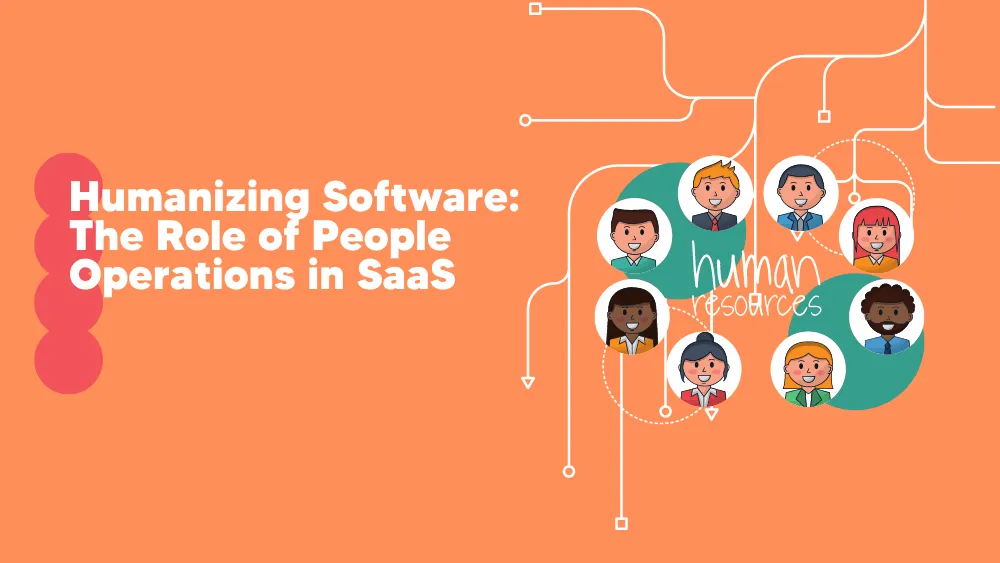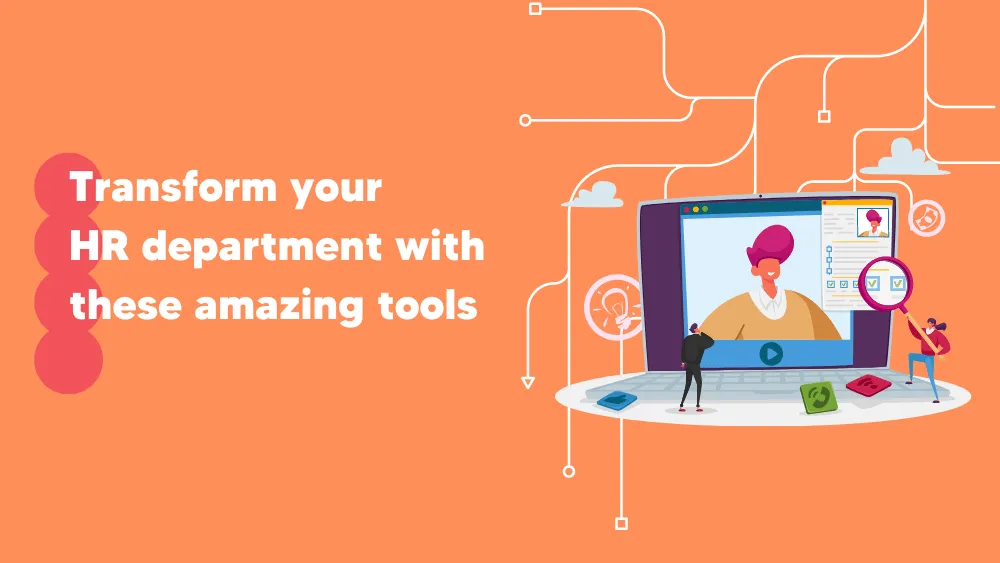Table of Contents
- The Cornerstones of Effective People Operations
- Crafting a Positive and Productive SaaS Work Culture
- Nurturing Talent in SaaS
- Saas for Your Saas – Platforms and Tools: The Building Blocks of Expertise
- Metrics in People Operations
- Anticipating the Challenges Ahead and Embracing the Innovations on the Horizon
Because even in a world of code, it’s people who truly click.
Remember the times when Human Resources was all about clocking in hours, mundane paperwork, and that dreaded annual review? Well, in the SaaS realm, that’s as outdated as dial-up internet. Enter: People Operations. It’s modern, it’s engaging, and it’s a game-changer.
Now, when most people hear “SaaS”, their minds jump straight to intangible lines of code, sophisticated algorithms, or perhaps that app they can’t live without. But here’s the thing– SaaS isn’t just about the software. Forget those 1s and 0s for a moment; the real powerhouse behind any successful SaaS venture? The programmers who miss sleep for that one stubborn bug, the marketers who can make even a ‘middleware integration platform’ sound snazzy, and the dreamers who see beyond the present, into a future brimming with digital promise.
So, as we dive deep into the heart of SaaS, it’s not the servers that make the magic happen. It’s the people. And in the dynamic world of software as a service, optimizing those very people operations is what makes the real difference between simple software and a software sensation.
The Cornerstones of Effective People Operations
Navigating the SaaS terrain requires a keen understanding of its most valuable asset: the people. Here’s a deeper dive into the facets of People Operations that can make or break success in this dynamic domain.
Talent Acquisition: More than Just Resumes
Talent acquisition is where it all starts. But let’s be honest, in SaaS, it’s not just about hiring; it’s about curating. You’re not merely looking for a list of qualifications on a resume; you’re seeking those who display passion, adaptability, and perhaps, a penchant for caffeine. It’s about recognizing potential, even if it’s hidden behind unconventional paths or experiences. The right talent is the one who’s ready to leap into the ever-shifting challenges of SaaS with both feet and, ideally, hit the ground sprinting.
Employee Development: The Future-Proofing Strategy
In the tech space, ‘being updated’ is last week’s news. It’s an industry where today’s innovation becomes a prerequisite by tomorrow. Employee development isn’t just about addressing current competencies but also about gearing up for the unseen next. It’s not enough to know the tools of today; there’s a need to anticipate, learn, and sometimes, even pioneer the tools of tomorrow. Continuous training sessions, workshops, and hands-on experiences? Those are your weapons in the battle of relevance.
Employee Well-being: Beyond Office Plants and Yoga Classes
Let’s get real: a ping pong table and occasional office fruit baskets aren’t the pinnacle of employee well-being. The rapid pace, the high stakes, and the relentless pursuit of excellence in SaaS can be exhilarating. But they can also be exhausting. Focusing on well-being is about recognizing that your team members are not just cogs in the machine, but humans with aspirations, emotions, and yes, limits. It’s about creating an environment where employees feel valued, understood, and rejuvenated. After all, burned-out minds rarely ignite innovation.
Feedback Mechanisms: The Unsung Catalysts
Feedback is the unsung hero behind sustained growth. It’s the undercurrent that keeps the ship steering clear of icebergs. But in the realm of SaaS, feedback isn’t just top-down. It’s lateral, bottom-up, inside-out, and sometimes even zigzag. Effective feedback mechanisms not only gauge the temperature of the room but also tap into the collective intelligence of the team. It’s about creating channels where ideas are not just heard but actively integrated. When everyone has a voice, solutions don’t just come from boardrooms but from every nook and cranny of the organization.
Crafting a Positive and Productive SaaS Work Culture
Dive into the depths of any successful SaaS company, and you’ll find more than just efficient algorithms and cutting-edge technologies. At its core lies a vibrant work culture that serves as the driving force behind every achievement. Like a heart-pumping lifeblood throughout an organization, an empowered work culture can turn aspirations into realities and challenges into opportunities.
The Ripple Effect: Culture’s Silent Echo in Product Quality
It’s a profound yet often overlooked truth: the nature of the work environment directly echoes the product’s quality. A motivated team working in a supportive environment will invariably produce solutions that are not just functional but exceptional. Conversely, a toxic work environment can act like sand in the gears, grinding processes to a halt and diminishing the end product’s quality. The essence of a company’s culture doesn’t remain confined within its walls; it reaches out, touching and influencing every user interaction.
Pillars of SaaS Work Culture: A Triad of Excellence
- Collaboration: SaaS isn’t a solo sport. It’s a relay race where the baton is passed between departments, from developers to marketers to customer support. Seamless collaboration ensures that transitions are smooth, ideas are amalgamated, and the final product is a harmonious blend of varied expertise.
- Flexibility: In the ever-shifting landscape of SaaS, rigidity is the antithesis of progress. Flexibility allows companies to adapt, pivot, and evolve as per market dynamics. It’s not about abandoning the plan; it’s about tweaking it to fit reality.
- Innovation: The SaaS realm thrives on novelty. A culture that prioritizes innovation is always a step ahead, not just meeting customer expectations but setting them.
Diversity and Inclusion in SaaS
A myriad of perspectives leads to a tapestry of ideas, making solutions more holistic. Furthermore, the link between diverse teams and stellar performance isn’t just anecdotal; it’s backed by data. But how do SaaS companies move from merely talking about diversity to genuinely embedding it? To truly embrace diversity and inclusion, SaaS companies can focus on:
- Hiring Practices: Looking beyond conventional pools to tap into diverse talent.
- Bias Training: Ensuring all team members recognize and dismantle their unconscious biases.
- Open Dialogues: Cultivating an environment where conversations about diversity are welcomed and encouraged.
- Mentoring Programs: Offering guidance and support for underrepresented groups, aiding their professional ascent.
The end game? An ecosystem where every voice matters, products that resonate universally, and a brand that stands as a beacon for genuine inclusivity.
Nurturing Talent in SaaS
Central to the forward momentum of the SaaS industry is the cultivation of talent, a task that goes beyond hiring the best and the brightest. It’s about ensuring that once onboard, these shining stars continue to burn bright and lead the way. Let’s break down the strategies that can keep this flame alive.
Growth Mindset: The SaaS Mantra
In an arena where technologies evolve overnight and today’s genius move might be tomorrow’s blunder, flexibility is king. Employees need to embrace the idea that skills and intelligence can be developed. The key? Recognizing that challenges are not roadblocks but stepping stones – every misstep is an opportunity, every feedback a goldmine. A growth mindset isn’t about knowing all the answers; it’s about relentlessly seeking them.
Leadership’s Role: More Beacon, Less Boss
In the world of SaaS, leadership is less about directing and more about inspiring. A great leader doesn’t just show the way but empowers others to discover paths of their own. They set the precedent by being the embodiment of the growth mindset, championing continuous learning, and appreciating the diverse tapestry of talents within their teams. It’s about creating an atmosphere where innovation is not just encouraged but celebrated, where risks are taken not recklessly but with informed audacity. When leaders lead by example, they don’t just build efficient teams; they craft legacies.
Saas for Your Saas – Platforms and Tools: The Building Blocks of Expertise
To keep up, employees must have access to the latest Human Resources platforms and tools for continuous learning – the gym equipment for the brain. Whether it’s online courses, simulation environments, or cutting-edge webinars, providing a variety of learning avenues can cater to diverse learning styles. This not only boosts proficiency but also fosters a culture where upskilling becomes as habitual as the morning coffee run.
- Recruitment Platforms: Tools like Greenhouse and Lever have diversity and inclusion modules that can help companies source talent more equitably. These recruitment platforms offer features that anonymize applications to reduce unconscious bias.
- Training Platforms: Apps such as Vercida and Paradigm offer training modules tailored to enhance inclusivity in workplaces. They provide resources on unconscious bias, allyship, and other key diversity topics.
- Feedback and Analytics: Platforms like Culture Amp or Peakon allow employees to give feedback anonymously. This can be invaluable in understanding workplace issues related to inclusivity. They also offer analytics to measure engagement, belonging, and other key metrics over time.
- Community Building Platforms: Apps like Donut can integrate with platforms like Slack to introduce team members randomly, thereby fostering connections between diverse groups within a company. This casual mixing can often lead to more profound inclusivity.
- Mentoring Software: Tools like Chronus or MentorcliQ can help set up mentoring programs within organizations. These platforms can pair individuals from underrepresented groups with mentors, ensuring they have the support to grow and thrive.
Metrics in People Operations
Aside from the aforementioned feedback, there are also a few metrics worth keeping an eye on as employees may be at times a bit shy when it comes to sharing their experience with a company. By interpreting these numbers wisely, companies can not only foresee potential issues but also pivot and accelerate in the right direction.
- Turnover Rate: A low rate often suggests employee satisfaction, while a high rate can hint at underlying issues.
- Employee Engagement Scores: High scores can indicate motivated teams; low ones might signal a need for cultural or operational shifts.
- Time-to-Hire: Speedy processes may speak to efficiency, but if too swift, might indicate hasty decisions.
- Diversity Ratios: Beyond just ethical considerations, diverse teams drive innovation and broader market understanding.
- Employee Net Promoter Score (eNPS): This metric provides a quick pulse on overall employee satisfaction and loyalty. It’s a direct reflection of how employees feel about the company and its culture.
- Training and Development ROI: This metric reveals the effectiveness of employee development initiatives. A strong ROI indicates that employees are gaining valuable skills that enhance their productivity and job satisfaction.
- Absenteeism Rate: Chronic absenteeism can be a telling sign of broader issues, such as burnout, dissatisfaction, or health concerns. Monitoring this rate can help companies identify and address potential problems early on.
Using these metrics provides companies with an X-ray view into their organization’s health. But it’s not enough to simply look at the numbers. You’ve got to act on them.
Case Study: Refining Work-life Balance Based on Feedback: The Asana Shift
Asana, a renowned work management platform, places immense emphasis on its employees’ well-being. In their early days, as rapid growth ensued, some employees felt the burn of an always-on work culture.
Feedback from their regular employee surveys highlighted this concern. Recognizing the issue, Asana took actionable steps. They introduced “No Meeting Wednesdays” to allow for uninterrupted work and implemented a “Deceleration” policy, where employees could request to work at 60% for 60% pay for a period, ensuring they could recharge without a significant financial strain. By adjusting their approach based on employee feedback and tracking work-life balance metrics, Asana not only enhanced its employees’ satisfaction but also ensured the retention of talent and maintained a high eNPS.
Anticipating the Challenges Ahead and Embracing the Innovations on the Horizon
The road ahead has its hurdles. By identifying these challenges early on, we can set the stage for smoother transitions and proactive solutions.
-
Scalability Concerns
As SaaS businesses scale, the complexity of their People Operations also grows. It’s no longer just about hiring more; it’s about ensuring that as you grow, the core culture and values are preserved. In this rapid scale-up, streamlined onboarding processes, clear communication channels, and maintaining organizational clarity become essential.
-
Remote Work Dynamics
The remote work revolution, fueled further by global events, presents both an opportunity and a challenge. The possibility of hiring talent from anywhere in the world is tantalizing. Yet, it brings forth issues of timezone coordination, fostering team unity without physical interactions, and ensuring that remote workers feel as valued and included as their in-office counterparts.
-
Global Teams, Local Sensitivities
Operating with teams scattered across the globe doesn’t just mean grappling with different time zones. It’s about understanding and valuing local customs, holidays, and work ethics. It’s about ensuring a Polish developer feels as integral to the company as a Californian marketer, celebrating diversity while nurturing unity.
-
Leveraging AI in Recruitment and Training
Artificial intelligence isn’t just for customer-facing applications. In People Ops, AI can streamline the recruitment process by sorting through applications to find the best matches, predict which employees are most likely to churn, or even personalize training modules for employees based on their learning styles and past performances.
-
Data Analytics for Proactive Solutions
Instead of reacting to problems as they arise, data analytics can help People Operations anticipate them. By analyzing trends in employee behavior, feedback, and performance, companies can make informed decisions, from preemptively offering training programs to adjusting policies that might not be resonating well.
-
Blending Tech with the Human Touch
While innovations like AI and data analytics can optimize processes, the essence of People Operations remains human. It’s about ensuring that amid all the technology, the human connection isn’t lost. After all, it’s people who drive the success of a SaaS company, and while technology can guide and assist, genuine human understanding and empathy will always be irreplaceable.
Conclusion
In the rapidly evolving world of SaaS, where algorithms and technologies dominate conversations, it’s imperative not to forget the beating heart of every successful venture – its people. As the digital tapestry of the future unfolds, it’s not just about optimizing code but about fostering, nurturing, and empowering those who create it. While tools and platforms play an indispensable role, it’s the human spirit, resilience, and passion that remain the cornerstone of success. People operations can be translated as constantly learning how to operate with other people and their needs at work.





